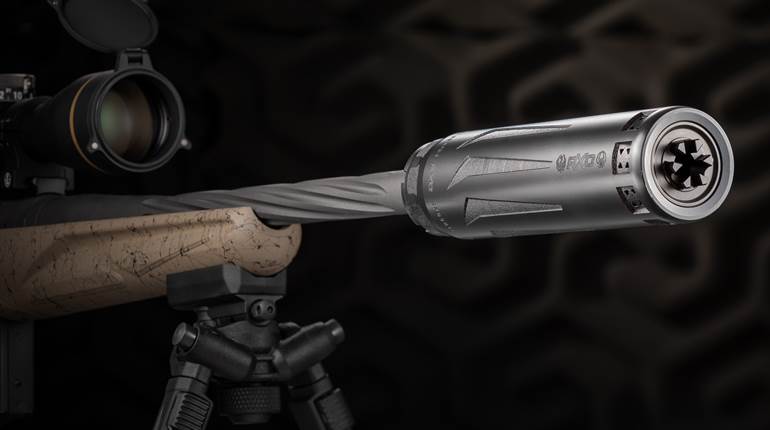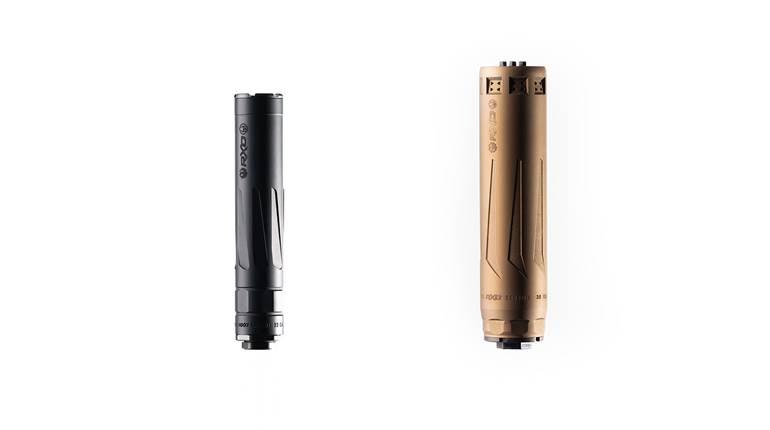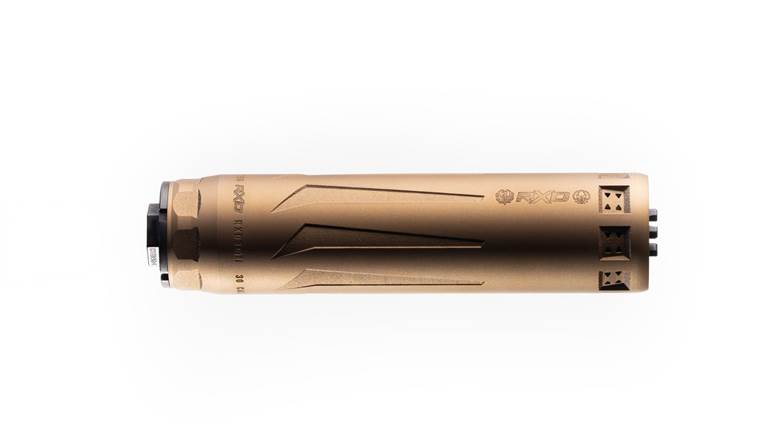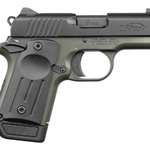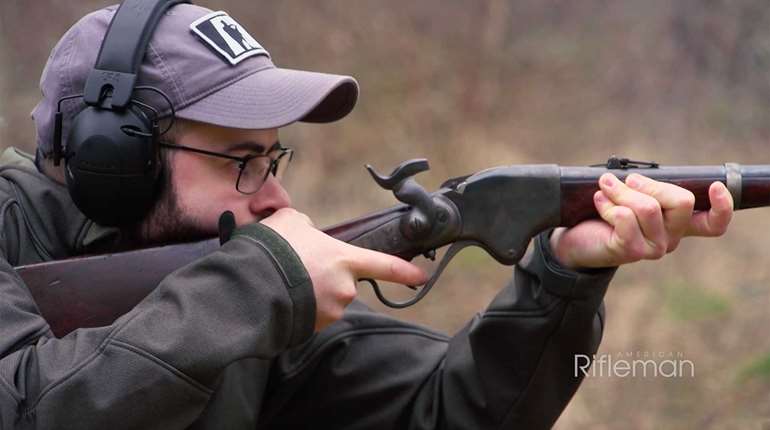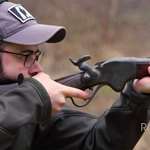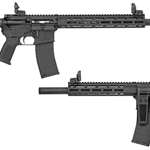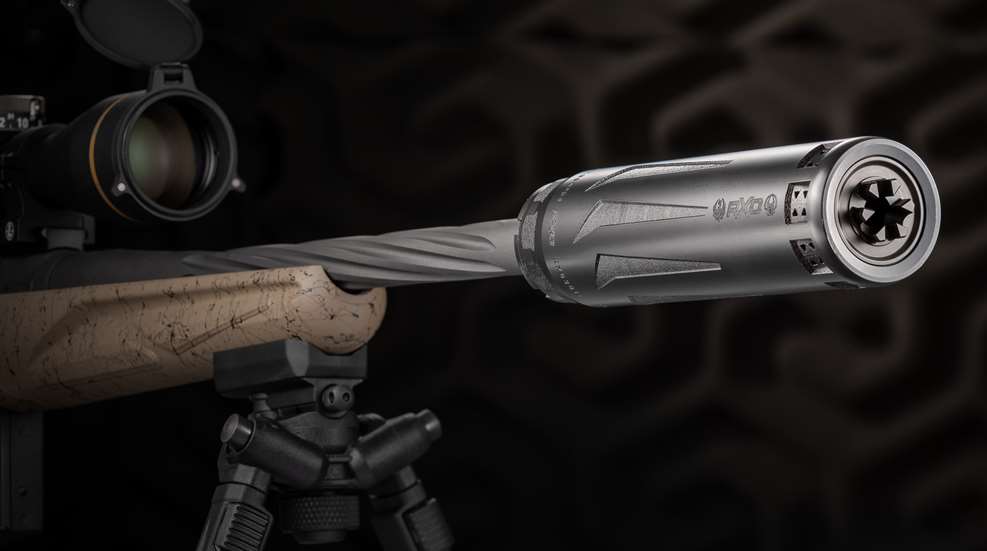
Sturm, Ruger & Co. is making friends all over the place. For, in manufacturing as in life, who you know can be just as important as what you know. Quickly proving that the company’s partnership with Magpul to design and produce the capable RXM 9 mm Luger semi-automatic pistol was no mere one-off, Ruger introduced the second member of its burgeoning RX series of intra-industry collaborations at this year’s NRA Annual Meetings with the announcement of the two-model RXD suppressor line. And, yet again, Ruger’s choice of dance partner illustrates just how much care and deliberation the gunmaker is putting into choosing its recent spate of corporate alliances. You see, in the same way that the “M” in RXM is short for Magpul, this time the “D” stands for Dead Air Silencers—a company that takes the science of sound mitigation and manipulation very seriously.
Although Ruger does have some previous experience with in-house suppressor production, with all due respect to 2016’s Silent-SR and the following year’s ISB, in hindsight, those early rimfire cans now seem like baby steps compared to the new, more-fully-realized, Dead Air-assisted models—and soon found themselves discontinued in 2020 as a result. The Ruger/Dead Air collaboration has borne two fruits thus far, the RXD22Ti and the RXD30Ti, which, as can be intuited from their names, are .22-cal. and .30-cal. silencers, respectively, composed predominantly of titanium.
Upon learning of their imminent launch, my curiosity in the far more versatile and practical RXD30Ti, in particular, was piqued—given that it is both the first centerfire-rated rifle can to bear Ruger’s name and the first designed expressly from conception to be a hunting suppressor. That interest then jumped up another level when I learned that Dead Air was involved, increased further when Ruger reached out with an opportunity to field test this specific model with Backcountry Hunts in bucolic-sounding Mountain Home, Texas, and maxed out entirely when I discovered that our quarry for this adventure would be axis deer. As the world’s best-tasting venison, axis is a species I personally try to hunt at every opportunity.

The groundwork for the RXD venture began several years ago as Ruger and Dead Air personnel found themselves sharing a campfire together. When the notion of a joint project came up, both parties were interested, and the work began in earnest in 2024. Together the companies outlined the series’ big-picture design priorities, with Dead Air then taking the lead on working out all the nitty-gritty engineering details and manufacturing the product at its Heber City, Utah, facility and Ruger handling the marketing efforts.
Of course, the primary purpose of all suppressors is to decrease a fired shot’s volume, but the intricacies of a particular design also influence its ability to mitigate recoil or gas blowback at the same time. Unfortunately, jack-of-all-trades designs tend to truly excel at none of the above, but with the especially well-devised ones you may get to pick two out of the three. Developed from inception to be a hunting silencer that will primarily be used aboard manually operated firearms, Ruger and Dead Air shrewdly chose to focus on cutting the former two concerns of noise and kick with the RXD30Ti. Given the slower rate of fire envisioned by its creators, the centerfire RXD is not full-auto-rated.
Building a suppressor through additive manufacturing, otherwise known as 3D printing, is one of the silencer industry’s hottest current trends, and both the .22- and .30-cal. RXDs take advantage of this advancement. Doing so offers benefits on both the development and manufacturing sides, yielding extreme tolerance control without requiring any weld points and allowing internal baffle shapes to be utilized that would be impossible to produce using a traditionally machined or turned design—while truly presenting no disadvantages compared to a conventionally welded suppressor.
Pretty middle-of-the-road dimensionally for its type, the RXD30Ti measures 7.31" in length and 1.75" in diameter, yet weighs a mere 12.4 ozs. including the stainless-steel mount thanks to its titanium construction. A sealed design that provides no user access to its internals, the entire body tube and its eight baffles are 3D-printed as one single piece of Grade 5 (6Al4V) titanium, an alloy widely utilized across numerous industries for its exceptional strength-to-weight ratio and corrosion resistance—qualities ideally suited to use in a silencer.
Not simply a derivative of an existing Dead Air product, the RXD30Ti is a blank-slate design that incorporates a number of features the company has developed through the years and utilizes them synergistically to maximize their effectiveness. Foremost among these are the integration of both the company’s Triskelion and Nomad baffle technologies, something Dead Air has never done before, creating a hybrid baffle structure that is only possible thanks to the model’s 3D-printed nature.
First appearing in Dead Air’s Mojave 9 pistol can, the geometry of the helically shaped Triskelion blast baffle (the first in the stack) has been carefully engineered to more efficiently pull a portion of the ignition gases away from the main flow of the suppressor. It also increases the surface area of the blast chamber, which adds volume that the gas sheared off from the main flow can take advantage of to slow down and cool. Dead Air has also found the Triskelion to be exceptionally resilient, making it a natural choice for applications involving powerful hunting cartridges and/or short barrels. The gases next encounter the seven subsequent Nomad baffles—notched, conical baffles that have been optimized to re-direct the gas into secondary chambers to further increase sound suppression.

Bookending the tube are a pair of screw-on 17-4 stainless-steel attachments—Dead Air’s 5/8x24 TPI Direct Thread Brake Mount and Flash Hider Front Cap. The former maintains the lightweight, streamlined profile of a direct-thread mount yet also incorporates an integral muzzle brake to kick-start the volume-reduction efforts, reduce blast-baffle erosion and extend the life of the suppressor. According to Dead Air, the six prongs in the front cap’s face re-direct gas away from the accessory’s “muzzle” to ensure that any unburnt powder doesn’t ignite. From the factory, the RXD30Ti ships with a 0.30" front cap, but this modular part is compatible with the company’s entire R-Series of front caps.
Within the suppressor world, contouring on the outside of a can is usually merely ornamental—there purely for marketing or aesthetic purposes—but occasionally it does serve a function. The RXD has examples of both types of exterior features. The repeating irregular pentagons that encircle the suppressor near its midpoint do provide a modicum of purchase while handling it but are mainly just for looks.
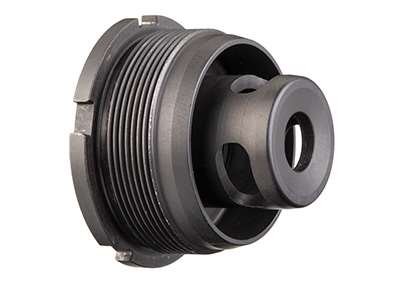
On the other hand, the eight small rectangles recessed into the unit’s front end actually do serve a very important practical purpose. Operating in a similar fashion to Dead Air’s popular E-Brake accessory, each is a port that siphons a bit of the gas from the interior of the suppressor and blows it out radially to further reduce recoil, an innovation that I’ve personally never seen integrated into a suppressor design before. But, boy, do those little holes make a big difference! The maker claims that the amount of reduction is approximately 40 percent, and the difference it made for my shoulder felt like every bit of 40 percent. Both the .22- and .30-cal. versions of the RXD are offered Cerakoted in either Black or Burnt Bronze, allowing for a bit of customization to your chosen platform.
Ruger/Dead Air’s RXD30Ti has a robust maximum cartridge rating of .300 PRC and a maximum muzzle energy rating of 4,400 ft.-lbs., however, the suppressor’s product page at ruger.com also includes a supremely helpful chart that lists not only 28 other compatible chamberings, but also the minimum barrel lengths required for safe use with each. For the sake of lumping things together into easy-to-digest categories, magnums such as 7 mm Backcountry and .300 Win. Mag. necessitate at least a 20" barrel while most intermediate and short-action chamberings (like .223 Rem., .243 Win., 7.62x39 mm and .308 Win.) need only a 12.5" barrel. And low-pressure, subsonic .300 Blackout loads can be fired through the can using barrels as minimal as 6". Also listed are a number of cartridges not compatible with the new silencer; unsurprisingly, each of the 20 examples involve projectiles of greater than .30-caliber—information which one would hope is common sense but that is nonetheless probably prudent to include.
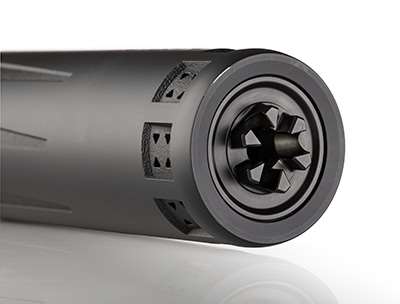
The concept of hunting with a suppressor continues to gain acceptance as more and more sportsmen reach the realization that the multiple advantages offered by a silencer in the field far outweigh the marginal ballistic loss of pairing a slightly shorter barrel with the accessory, with both options being closer in overall length and weight than some might think. It just comes down to priorities: Does your application really require that you squeeze every drop of external ballistic potential out of your rifle and its cartridge? Or is fielding an accessory that protects both your ears and your shoulder by greatly cutting report and recoil, completely eliminates muzzle flash, renders your shot far less likely to spook other game in the area and helps maintain positive neighbor relations a worthwhile trade-off for shaving a few dozen feet per second off your projectile’s velocity?
I can tell you from my own personal experiences over the years that the situations where the former was of paramount importance are far outnumbered by the circumstances where optimal velocity was not required and I would have gladly traded it for the latter suite of benefits. And yet, despite how frequently I use this platform to preach the good word of suppressor use, it actually wasn’t until this May’s axis deer hunt that I took one with me afield.
According to the American Suppressor Ass’n, 42 states currently permit suppressor ownership, all but one of which also allow that can to be used while hunting—sorry Connecticut. At this point, the board more or less appears to be set, as it’s hard to envision any firearm wisdom permeating the remaining eight states, but I implore you to take advantage of the practice if your state is in the majority that doesn’t infringe upon this particular freedom.
So it was that I found myself in central Texas in pursuit of a freezer full of meat, making the trip in May because of the axis deer’s unusual late-spring/early-summer mating habits. Our tools for the expedition: a Ruger American Rifle Generation II Ranch chambered in 6 mm ARC, loaded up with Hornady’s incredibly aerodynamic 103-grain Precision Hunter ammunition, and accessorized with a new Leupold VX-6HD 2-12X 42 mm scope and the RXD30Ti.
The Gen II Ranch is an exceptionally handy carbine, measuring just 37.25" long and weighing right around 6 lbs. depending on the chambering, which makes it the perfect companion for any can, let alone one also designed around flyweight utility. For its part, the RXD is lighter than it appears, and the combination of rifle, scope and silencer was quite pleasant to tote across the gently sloping terrain that gives Texas Hill Country its name.
My hunt was over almost before it started—something my wonky back will never complain about. Having scouted the area the evening before, Guide Dave Callaway and I returned at first light to overlook a valley where we knew several axis to be. Although we could hear other bucks in the vicinity, we quickly glassed a broad-chested shooter cruising for females alone at 250 yards and carefully but swiftly started closing the distance thanks to the nearby scattered brush and favorable wind conditions.
We finally found the perfect place for an ambush at roughly 130 yards, set up the sticks and waited for the buck to exit the draw he was ambling down. Presented with a clean broadside, I pulled the trigger when he stopped walking for a brief second, perforating both lungs and dropping him within about 20 yards of where he was hit. The 6 mm ARC cartridge is soft-shooting enough on its own, but the addition of the RXD brought its recoil down to .223 Rem. levels during practice fire and rendered it completely unmemorable when the time came to take the shot on the deer. And, the RXD had so muted the rifle’s report that immediately following the shot we could still hear the other males in the area vocalizing—his buddies had no clue that anything had happened.
Upon field dressing the deer, we were able to recover the bullet, as it had penetrated fully before getting caught in the beast’s hide on the far side. The 0.243" projectile had impressively expanded to about 0.50" on average and measured 0.537" at its widest point. One benefit of harvesting your animal on the first day of the hunt is that it turns the rest of your trip into a relaxing photo safari—however, I did have an opportunity later in the week to confirm that 6 mm ARC also makes for excellent impromptu skunk medicine.
While I would never discourage anyone willing to wear hearing protection while hunting from doing so, and I did have my favored set of Axil GS Digital earbuds in at the time, the perceived reduction in shot volume caused by the RXD30Ti was so great that I really wanted to get back to a sound meter so that I could put a concrete number to it. So, once returned from the trip, the same combination of rifle and load—both with and without the suppressor—was shot using a Larson Davis LxT1 to calculate just how much of a difference the can was making.
With the microphone positioned at a point 6" from the shooter’s ear, five unsuppressed shots were fired to establish a baseline, followed by five more through the silencer. The five shots fired without the RXD came to an average of 159.3 dBs, while the suppressed quintet registered only 132.7 dBs, for a reduction of 26.6 dBs. This is an impressive amount of mitigation for a supersonic hunting load—and the low tone produced by the silencer was so agreeable that it was almost soothing. At 100 yards, the suppressed group landed about 2" directly south of the unsuppressed one, and would not be difficult to correct for.
At the risk of sounding like a broken record: A suppressor improves darn near every aspect of the shooting experience, flat-out making a trip to the range more enjoyable and safer, and a home-defense scenario more likely to be survived and less likely to cause lasting damage to your hearing. Thanks to my experience with the RXD30Ti in the field, I now also have firsthand appreciation for just how applicable those same benefits can be to the sportsman—and both months of delicious meat and a beautiful trophy to show for it.
Dead Air is one of the best in the business at using state-of-the-art manufacturing and sound-mitigation techniques to cater the design of a can to a specific application, and my testing proved that Ruger chose wisely in deciding to partner with the company on a hunting suppressor. If the silencer’s priorities were to lessen its host rifle’s volume and recoil, while not rendering the package overly ungainly, its results not only met my expectations in each of these regards but exceeded them. The RXD30Ti’s recoil-reducing qualities during the hunt were particularly eye-opening—with subsequent range testing on my personal 6.5 mm Creedmoor Savage 110 Magpul Scout being equally soft-shooting. And while hunting may have been the project’s primary focus, I can easily envision the advantages it offers making the centerfire RXD a force to be reckoned with within the precision-bolt-action space as well.
Paul Pluff, Ruger’s public relations manager, was my Hill Country hunting partner, and I used the opportunity to pepper him with questions about both the RXD in particular and the line’s future in general. While Paul remained cagey regarding any specifics, he did divulge that the company has been so pleased with the results from the first two RX projects that more such partnerships are “absolutely under consideration.”
Legendary basketball coach John Wooden once said, “Show me your friends, and I’ll show you your future.” If the RXM and RXD30Ti are any indication of what’s yet to come, then I think Ruger’s future is in good hands—and I am here for it.












